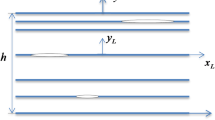Conclusions
-
1.
The theory of thin plates was used to obtain relations for compensation of thermal deformation by a heat flow (in relation to the time) acting on the rear of an element.
-
2.
The theory of thin plates can be used with an accuracy acceptable for practice (if edge effects are ignored) in calculations for thermal compensation of multilayered elements with H/2R≤1/3. For elements with H/2R≥1/3 (disks, cylinders), this theory yields sizable errors. In the case, the effect of the compensating heat flux is weakened considerably, and at a value of H/2R close to unity such compensation for strain of the working surface cannot be achieved: waves are created on this surface.
-
3.
The presence of a porous filler reduces the possibility of thermal compensation of working-surface strains. When a solid cylindrical band is placed about the periphery of a layer of porous filler, the bond between the outside layers is reestablished and the possibility of thermal compensation of strains is improved.
Similar content being viewed by others
Literature Cited
V. V. Apollonov, A. M. Prokhorov, V. Yu. Khomich, and S. A. Chetkin, “Thermoelastic effect of periodic-pulsed laser radiation on the surface of a solid,” Kvantovaya Élektron.,9, No. 2, 343–353 (1982).
G. W. Sutton, “Model for thermal distortion of high-energy repetitively pulsed laser mirrors,” J. Energy,5, No. 6, 344–354 (1981).
Yu. A. Zeigarnik, S. A. Kovalev, E. Z. Korol', and G. B. Rybinskaya, “Analysis of the strain state of a thin layer of a multilayered plate during its heating,” in: Heat Transfer and Thermal Strains in Cooled Multilayered Systems [in Russian], Inst. Vys. Temp. Akad. Nauk SSSR, Moscow (1982), pp. 5–57.
S. A. Kovalev, E. Z. Korol', and G. B. Rybinskaya, “Thermal compensation of strains of heated multilayered plates,” in: Heat Transfer and Thermal Deformation in Cooled Multilayered Systems [in Russian], Inst. Vys. Temp. Akad. Nauk SSSR, Moscow (1982), pp. 57–64.
V. P. Isachenko, V. A. Osipova, and A. S. Sukomel, Heat Transfer [in Russian], Energiya, Moscow (1975).
L. J. Segerlind, Use of the Finite Elements Method [Russian translation], Mir, Moscow (1979).
O. Zenkevich, Finite Elements Method in Engineering [Russian translation], Mir, Moscow (1975).
S. V. Belov, Porous Metals in Machine Construction [in Russian], Mashinostroenie, Moscow (1981).
Additional information
Institute of Mechanics of Moscow State University. Institute of High Temperatures, Academy of Sciences of the USSR. Translated from Problemy Prochnosti, No. 2, pp. 100–104, February, 1987.
Rights and permissions
About this article
Cite this article
Zeigarnik, Y.A., Kovalev, S.A., Korol', E.Z. et al. Thermal compensation of strains of the outside surface of multilayered plates during axisymmetric heating. Strength Mater 19, 256–262 (1987). https://doi.org/10.1007/BF01523513
Received:
Issue Date:
DOI: https://doi.org/10.1007/BF01523513




